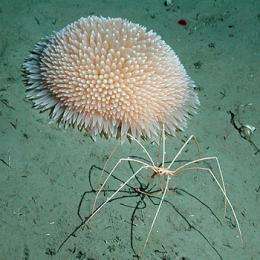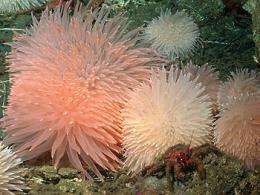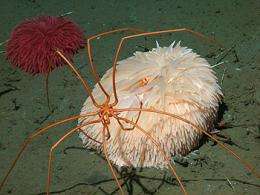Sea spiders and pom-pom anemones

(PhysOrg.com) -- Creeping slowly across the deep seafloor on long, spindly legs, giant sea spiders are found in many deep-sea areas. But, as with many deep-sea animals, we know very little about how sea spiders live. A recent paper by MBARI-affiliated researchers shows that sea spiders suck the juices out of deep-sea anemones. The researchers also discovered several locations where both anemones and sea spiders congregate in the dark depths of Monterey Canyon.
Although they look somewhat like land spiders, sea spiders are an entirely separate class of animals, known as pycnogonids (pronounced "pick-no-gone-ids"). Pycnogonids are "suctorial" predators—most species feed by sucking the bodily fluids from other marine animals. Pycnogonids are fairly common in tide pools, but these intertidal species are typically small and hard to see. In contrast, deep-sea pycnogonids can grow to over 50 cm (20 inches) across, and spend much of their time on the open seafloor.
The authors of the recent article did not originally set out to learn about sea spiders. The lead author, former MBARI postdoctoral fellow Caren Braby, worked with MBARI senior scientist Robert Vrijenhoek and a team of researchers who were studying the weird worms and other animals that grow on dead whales whose carcasses sink to the seafloor.

One of these "whale falls" is located 3,000 meters below the surface in the outer reaches of Monterey Canyon. The researchers visited this whale fall numerous times using MBARI's remotely operated vehicle Tiburon, to study how how the community of animals at the whale fall changed over time.
The researchers soon noticed that every time they visited this site, they saw pycnogonids. Even more interesting, most of the pycnogonids were near pom-pom anemones—large, round anemones that roll around the seafloor like tumbleweeds. In fact, the researchers also noted that groups of pom-pom anemones and debris frequently accumulated near this particular dead whale just as tumbleweeds and trash pile up against a barbed wire fence.
During several ROV dives, the researchers came upon pycnogonids that were crouched directly over pom-pom anemones. Zooming in one of these encounters with the ROV's video camera, the researchers could see that the pycnogonid had inserted its proboscis into one of the anemone's tentacles. Apparently the pycnogonids were not devouring entire anemones, but were simply sucking the juices from the anemones' tentacles, one at a time. In one case, the researchers even videotaped a pycnogonid removing a couple of tentacles from a pom-pom anemone and walking away, holding them in its mouthparts like a take-out dinner.
Overall, the pom-pom anemones seemed to survive periodic pycnogonid attacks without too much difficulty, although the researchers did note that the affected pom-pom anemones "had a wilted appearance compared with their neighbors." Thus, the pom-pom anemones may serve as a "renewable resource" for the pycnogonids.
Other species of anemones were not so lucky. The pycnogonids also fed on smaller anemones that attached themselves directly to the whale bones. In such cases, the pycnogonids typically plucked entire anemones from their perches and then walked away to devour the animals at their leisure.

In addition to congregating around the whale carcass, pycnogonids and sea spiders also frequented a piece of driftwood and a large field of deep-sea clams nearby. Like the whale carcass, such debris and clam beds serve as food-rich oases in the flat, muddy expanse of the deep seafloor. They also stick up above the surrounding sediment, creating eddies in ocean-bottom currents. Such eddies allow debris and pom-pom anemones to accumulate. The researchers speculate that pycnogonids may seek out such areas to take advantage of the relatively abundant (and immobile) food supply.
The recent paper provides yet another example of how "chance" observations can lead to new discoveries in the poorly understood environment of the deep sea. In addition to providing one more piece in the jigsaw puzzle of a deep-sea food web, this discovery helps marine biologists understand how deep-sea animals can survive on sources of food that are both ephemeral and widely dispersed.
More information: C. E Braby, V. B. Pearse, B. A Bain, R. C. Vrijenhoek (2009).Pycnogonid-cnidarian trophic interactions in the deep Monterey Submarine Canyon, Invertebrate Biology, 128 (4), 359-363.
Provided by Monterey Bay Aquarium Research Institute



















